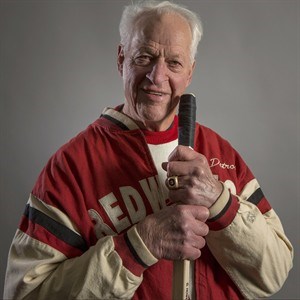
Gordie Howe is shown a a recent handout photo from the new book "Mr. Hockey."
Image Credit: THE CANADIAN PRESS/HO-Paul Horton/Neue Studios
October 11, 2014 - 8:26 AM
TORONTO - Like his playing days, Gordie Howe's career as an author has spanned decades.
"Mr. Hockey: My Story" arrives almost 30 years after "And ... Howe!: An Authorized Autobiography" by Gordie and Colleen Howe, and 25 years after "Gordie Howe: My Hockey Memories" by Howe and Frank Condron.
Howe's Hall of Fame career has spawned books by others, including "Nine: A Salute to Mr. Hockey," by Bob Duff. Son Mark Howe wrote his own book "Gordie Howe's Son, A Hall of Fame Life in the Shadow of Mr. Hockey."
Sixty-eight years after his NHL debut, Gordie Howe's story is still a good read — a slice of Canadiana.
Born in 1928 in Floral, Sask., Howe grew up in Saskatoon during the Great Depression. Howe relates that on the day he was born, his mother was chopping wood when the labour pains began. Howe was the sixth of nine children so she knew what to do. She cut the umbilical cord herself and waited for her husband to come home.
It was another era. There was no indoor plumbing and the Howe kids took a lot of their baths at school. An eight-year-old Howe delivered pamphlets for a local grocery store. He hunted gophers with a handmade slingshot for a penny a tail and sold fish he caught to a Chinese restaurant for five or 10 cents apiece.
Howe writes how his father Albert taught him "not to take dirt from anyone, because if you do they'll just keep giving it to you."
It's a life lesson that served Gordie well during his long hockey career. The book is filled with stories of Howe waiting to take revenge on the ice.
Respect equals space, Howe soon learned.
Rangers tough guy Lou Fontinato ultimately paid the price for carving open Howe's face with his stick in early 1959. Howe bided his time before thumping him up in a one-sided fight that left his rival bloodied with a relocated nose. Howe dislocated a finger during the beating.
"It didn't make me happy to see Louie in such bad shape, but I can't say I felt sorry for him," writes Howe.
Both were doing their jobs, he reasoned, and one of them was going to get hurt.
Later, wife Colleen convinced Howe to invite Fontinato to a charity fundraising dinner in Vancouver. He accepted and the two became firm friends.
Howe waited four games before cold-cocking Stan Mikita for another stick violation. Some might call it a cheap shot, he admitted. "To my way of thinking, though, it was just payback."
Howe's awkward courting of Colleen — as well as his sappy letters to her — offer a very different view of the hard man on the ice.
Colleen, who died in 2009, was Howe's rock as well as his partner. She went on to become a canny business manager — the book notes both Mr. and Mrs. Hockey are registered trademarks.
Howe was just 15 in his first NHL training camp, in 1943 with the Rangers. With players away at war, NHL teams were scouring for talent.
But he launched his NHL career as a Red Wing, making his debut Oct. 16, 1946, against the Maple Leafs.
Again, it was a different era. Howe writes how general manager Jack Adams wielded almost total control over his players, whom he traded like hockey cards. Adams, whom Howe calls Mr. Adams, disapproved of booze, sex and women — even wives — because he saw them as distractions.
Howe admits to being naive in his business dealings, learning years later the club had lied to him about how good his salary was in comparison to others.
While not a tell-all book, Howe does not hide his occasional discontent with the Detroit organization or teammates. And Howe, while respectful to today's game and players, clearly believes the Original Six era was tougher.
"That's not the same as saying that today's players aren't tough, just that the game itself has changed," he writes. "When there were only six teams, every player in the league came prepared to claw over his best friend the second the puck dropped."
Howe's longevity as a player — he was 52 when he retired at the end of the 1979-80 season after 32 pro campaigns — is stunning when he lists the price his body paid on the ice. He estimates his nose has been broken 14 times and he has taken more than 300 stitches to the face.
He has broken fingers, toes, wrists, feet and collarbone as well as had a hole drilled in his skull after a 1940 encounter with Teeder Kennedy. There were knee surgeries and a detached retina.
These days, Howe bears a different cross.
In an afterword from Marty, Mark and Murray Howe and Cathy Purnell, the Howe children cite Gordie's cognitive impairment, a form of dementia, the past few years.
"It has been a very slow decline over many years, although it has become more noticeable recently," they write. "His memory just isn't what it once was.
"At 86, Gordie is becoming frail for the first time in his life. It is sad to see him struggle at things we all take for granted, things he wouldn't have given a second thought only a short time ago."
Howe lives with his kids, rotating from one house to another.
Howe has the sole writing credit, although in his acknowledgments he thanks Paul Haavardsrud "who helped to take the thoughts in my head and put them down on paper."
The book, which features a foreword from Bobby Orr and back-page blurb by Wayne Gretzky, comes out Oct. 14.
— "Mr Hockey: My Story," by Gordie Howe. Viking, 229 pages, $32
News from © The Canadian Press, 2014